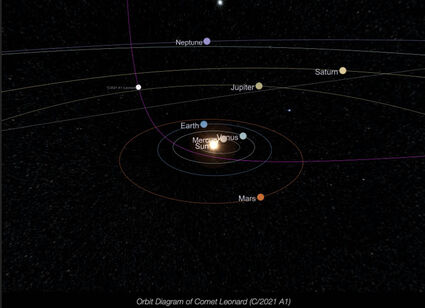Comet Leonard, and its glorious sweep past M3

This perspective on Comet C/2021 A1 (Leonard) shows its trajectory through our solar system. North is up. You can see that its orbit will cause it to be initially visible from Earth's Northern Hemisphere, and then from the Southern Hemisphere. Chart via The Sky Live.
By Eddie Irizarry and Deborah Byrd.
A much-anticipated comet – C/2021 A1 (Leonard) – is likely to be 2021's best comet, and its brightest comet by year's end. The comet is currently heading sunward, toward its perihelion (closest point to the sun) on January 3, 2022. Comets are typically brightest around perihelion. Comet Leonard has been in the morning sky, and it just passed the beautiful globular star cluster M3. This month, Comet Leonard will become visible in the evening sky.
Astronomer Greg Leonard discovered the comet as 2021 began. Discovery images already showed a tail for the comet, suggesting we might see a nice tail as Comet Leonard draws closer to the Earth and sun. And telescopic observers and astrophotographers can see a tail with certain equipment.
Over the coming month, as Comet Leonard heads sunward, it'll sweep closest to Earth on December 12. It won't be particularly close at its closest, passing more than 21 million miles (34 million km) away. But six days later – on December 18 – the comet will have an exceptionally close pass of Venus of just 2.6 million miles (4.2 million km). Then it'll round the sun on January 3, 2022, at a distance of about 56 million miles (0.6 AU, or 90 million km).
According to TheSkyLive.com on November 28: The current estimated magnitude [brightness] of Comet Leonard (C/2021 A1) is 10.64 (JPL) while the latest observed magnitude is 7.5 (COBS).
So, again, Comet Leonard is too faint to see with the eye. But it's a good binocular comet now and might be possible to be glimpsed with the eye alone in dark skies as 2021 draws to a close.

Or maybe not. Comets are unpredictable. But C/2021 A1 (Leonard) is very much a comet worth watching.
Will you see Comet Leonard?
Will the comet get bright enough to see with the eye alone in December? It's possible that Comet Leonard might reach 4th magnitude before its early January perihelion. But comets are diffuse bodies, not pinpoints. So, a 4th-magnitude comet won't appear as bright to your eye as a 4th-magnitude star. The star would be easily visible in a dark sky. The comet? At 4th magnitude, it would be a good binocular comet, possibly glimpse-able with the eye alone. It would be fun to try to see and even more fun to spot it.
This comet is initially in Northern Hemisphere skies. But it will become visible from the Southern Hemisphere in December 2021 and January 2022.

Remember, you need a dark sky. And you'll need a pair of binoculars ... ordinary 10×50 binoculars from a discount store is a reasonable way to go.
If you do see it, it'll look like a fuzzy star.
Nature provides us with sky events seen once in a lifetime. Comet Leonard might be one of these, if it gets bright enough.
By that we mean that this comet takes tens of thousands of years to complete an orbit around the sun. As Bob King pointed out at Skyandtelescope.com in October 2021: Orbital calculations revealed that the object had spent the last 35,000 years wending its way sunward after reaching aphelion at the chilling distance of around 3,500 AU (3,500 times the distance between our Earth and sun].
In other words, after this current close sweep past our sun, you or I won't see Comet Leonard again.

Ultrafast comet
An amazing feature of this celestial visitor is that it's an ultrafast comet. It's traveling at 158,084 miles per hour (254,412 km/h or 70.67 km/second) relative to Earth.
Despite its incredible speed through the vast space of our solar system, don't expect to see this comet swoosh across the sky. Like planets, comets do move in front of the star background, but only very slowly due to the large distances involved. Is it possible to observe this comet's motion? Yes, if you're a careful observer and willing to spend some time. The best way would be with a small telescope. You'd do it by taking a close look at the comet's position relative to background stars. Then compare the telescopic view five or 10 minutes later to detect the comet's motion. Despite its high speed, you'll find that its distance from Earth – and the vast distances in our solar system – will cause the comet to appear as a very slow-moving object.
This article was originally published by EarthSky and can be found online at: https://earthsky.org/astronomy-essentials/comet-leonard-might-become-2021s-brightest-2022/


Reader Comments(0)